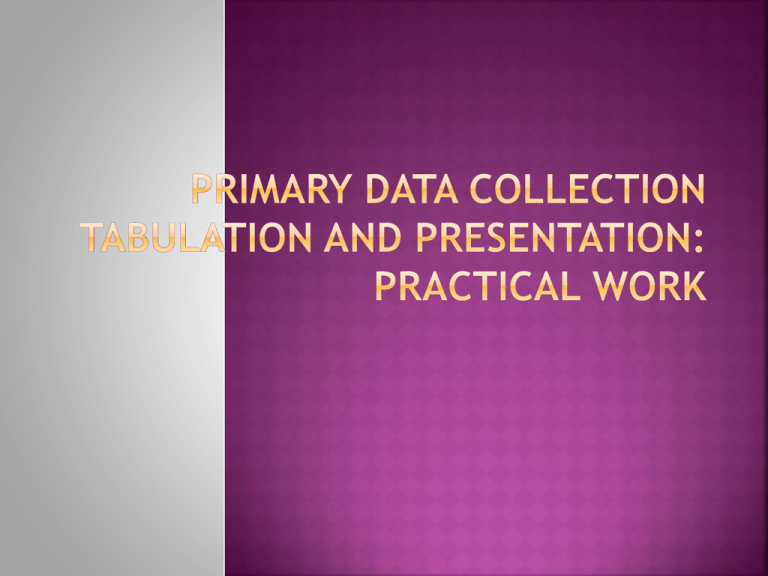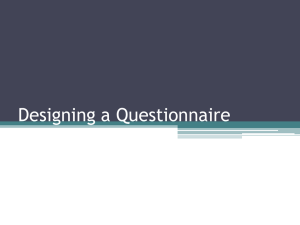
The word ‘data’ is plural of the Latin
word ‘datum’ which means an
individual fact, statistic, or piece of
information. Data are the core of
statistical analysis. Data can be
collected mainly from two sources,
Primary and secondary.
Primary Data: Data collected by the
investigator himself from primary
sources is called primary data. It is also
termed as original data because it is
collected for the first time by a person
who will use them.
According to Horace Secrist
“By primary data are meant those
data which are original, that is,
those in which little or no grouping
has been made, the instance
being recorded or itemized
as encountered. They are
essentially raw materials.”
Secondary data. Data collected by some
other person or organization for their own
purpose are called secondary data. Such
data are available either in published or
unpublished form.
For example data available in Journals,
reports, Economic Survey, Budgets, Govt.,
RBI,
Publication.
Publications
of
Universities, Research Bodies, Trade and
Professional organizations etc. are all
sources of secondary data which can be used
by any investigator.
Distinction Between
Secondary Data.
Primary
And
According to Horace Secrist “the
distinction
between
primary
and
secondary data is largely one of degree.
Data which are secondary in the hands of
one party may be primary in the hands of
another.”
Methods of Collecting Primary Data
Primary data can be collected either by
the census either by the census method in
which each and every unit of the universe
is counted (for example to know about the
total wheat production in Punjab, we have
to approach each and every farmer
cultivating wheat) or by the sample method
in which only selected units of the universe
are counted.
PRIMARY DATA CAN BE COLLECTED BY THE
FOLLOWING METHODS:
Direct Personal Investigation. Here the interviewer
collects the data personally from the respondents
and (persons from whom data are to be collected)
thus the data are reliable. But here the data may be
influence by the personal prejudices of the
interviewers.
Indirect Oral Observation. The information is
collected indirectly from a third person called a
witness. For example information regarding use of
intoxicants : drugs, alcohol etc. The reliability of the
data depends on the integrity and honesty of the
witness.
Information Through Correspondents. In this method
local agents or correspondents are appointed to send
the information to the principal Investigator on a
regular basis. For example information regarding
strikes,
lock-outs,
accidents
in
industrial
establishments etc. Accuracy of the information will
depend upon the degree of unbiasedness of the
reporters and agents.
Schedule Method. A schedule is a set of questions
which are asked and filled by the enumerator
himself. In this method the investigator personally
goes to the respondent. This is the most accurate
method but it is very costly and time consuming
technique.
Questionnaire
Method. A formal list of
questions is called a ‘questionnaire’. The data can
be collected by preparing a questionnaire and
getting it filled through various ways of
communication viz. personal interview, mail,
telephone etc., The data collected by the personal
interview is comparatively more accurate as the
interviewer can remove the doubts, if any, of the
respondents and thus collect the data.
In the mailed questionnaire method, the respondents
are supposed to return by post the duly filled
questionnaire. Through this method information can be
collected from any place connected by post.
Information can also be collected through telephone as
in the case of personal interview. But everybody may
not be having telephone. Moreover telephone
information may be erratic and unreliable.
According to W.M. Harper
“The questions should be so
designed that the questions fall into a
logical sequence. This will enable the
respondent to understand the purpose
and as a result the quality of his answer
may be improved.”
Qualities of Good Questionnaire
1. (a) COVERING LETTER. A polite covering letter
should be sent to the respondents along with
the questionnaire mentioning the purpose,
need, and usefulness of the information
required and how it would benefit them.
(b) Respondents should be ensured that the
information supplied by them would be kept
confidential.
(c) Some inducement (compound, concessions,
free gifts etc.) should be offered to ensure return
of the filled questionnaire.
(d) The respondents may be promised a copy, of
the results of the survey, if they so desire.
2.The questions should be very short, simple and
objective type.
3.The number of questions should not be very
large; preferably it should be within 15 to 20.
4.Straight answers viz. Yes or No, type questions
should be asked.
5.Personal questions should not be asked e.g.
number of children, bankruptcy etc.
6.Questions requiring calculations like ratio, rates,
percentage etc. should be avoided.
7.Instructions to the respondents regarding filling
the questionnaire should be given. Units of
measurements, kilograms, liters, metric tones etc.
must be clearly stated
Pre-Testing the Questionnaire
(Or Pilot Survey)
Before finalizing the questionnaire its
draft should be got filled from a very
small sample of informants selected
from the relevant universe.
After pre-testing, the questionnaire
can be modified, if required, in order to
collect
adequate
and
accurate
information.
SPECIMEN QUESTIONNAIRE
Draft a questionnaire containing 10
questions for that purpose.
A. General
•Name
•Permanent Address
Age
Sex
Male
Female
Martial status
Married
Unmarried
B. Economic conditions
1.What is the average income of your father or guardian?
2.How many persons are dependent upon your father or
guardian?
3.On an average how much money (in Rs.) per month your
father or guardian sends you?
4.From economic point of view whether this amount is
sufficient?
5.In comparison with your friends what is your level of
expenditure?
C. Study Habits
6.What is your class attendance level?
7.Whether your teachers are satisfied with your studies?
8.In addition to study in class how much time on an
average you devote in the library. Reading Room and
hostel?
9.On an average how much time you spend in studying
other material than the subjects?
10. Generally what do you study besides your subjects
and with what aim?
EDITING PRIMARY DATA
After collecting the data through
any of the above methods, editing
should be done. Editing means
detecting of errors of omission and
commission. Editing leads to
completeness, consistency, accuracy
and homogeneity of the data.
CLASSIFICATION OF DATA
According to L.R. Connor
“Classification is the process of
analyzing thing in groups of classes
according to their resemblance or
affinities and give expression to the
unity of attributes that may subsist,
amongst a diversity of individuals.”
In the words of J.R. Hicks, “Classified
and arranged facts speak themselves,
unarranged they are as dead as mutton.”
So classification is the process of
arranging the data in groups of classes
according to their common characteristics
and similarities.












